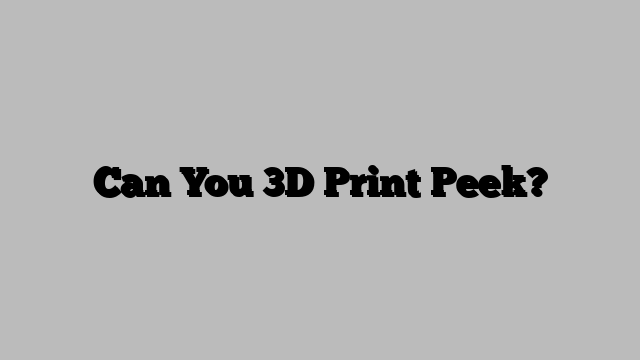PEEK, or Polyether Ether Ketone, is a high-performance engineering thermoplastic that is known for its excellent mechanical and thermal properties. It is often used in demanding applications such as aerospace, automotive, and medical industries. But can you 3D print PEEK? In this article, we will explore the answer to that question and provide actionable insights to make you knowledgeable on the topic.
The short answer is yes, you can 3D print PEEK. However, it is not as simple as printing with other materials like PLA or ABS. PEEK has a high melting point of around 343°C, which means it requires a specialized 3D printer with a heated build chamber to prevent warping and cracking during the printing process.
There are several methods of 3D printing PEEK, including Fused Filament Fabrication (FFF) and Selective Laser Sintering (SLS).
Fused Filament Fabrication (FFF)
FFF is the most common method of 3D printing PEEK. In this method, PEEK filament is melted and extruded through a heated nozzle to create the desired shape layer by layer. A heated build chamber is required to prevent the printed part from warping or cracking during the cooling process.
To print with PEEK, a 3D printer with a high-temperature extruder, a build chamber temperature of at least 100°C, and a build platform made from a heat-resistant material such as glass or ceramic is necessary. PEEK also requires a controlled environment with low humidity to prevent moisture absorption.
Selective Laser Sintering (SLS)
Selective Laser Sintering is a powder-based 3D printing method that uses a laser to fuse layers of PEEK powder together to create a solid object. This method can produce complex and intricate shapes that are difficult to achieve with other methods. However, SLS is a more expensive method and requires specialized equipment.
When it comes to printing with PEEK, there are a few things to keep in mind:
PEEK is a high-temperature material and requires a 3D printer with a high-temperature extruder and a heated build chamber.
The build platform should be made from a heat-resistant material such as glass or ceramic to prevent warping and cracking.
PEEK is sensitive to moisture and requires a controlled environment with low humidity.
PEEK is an expensive material, so it’s essential to optimize the printing process to minimize waste and reduce costs.
3D printing with PEEK is possible, but it requires specialized equipment and a controlled environment. Fused Filament Fabrication (FFF) and Selective Laser Sintering (SLS) are two common methods of 3D printing PEEK. With its excellent mechanical and thermal properties, PEEK is an attractive material for high-performance applications in various industries.
